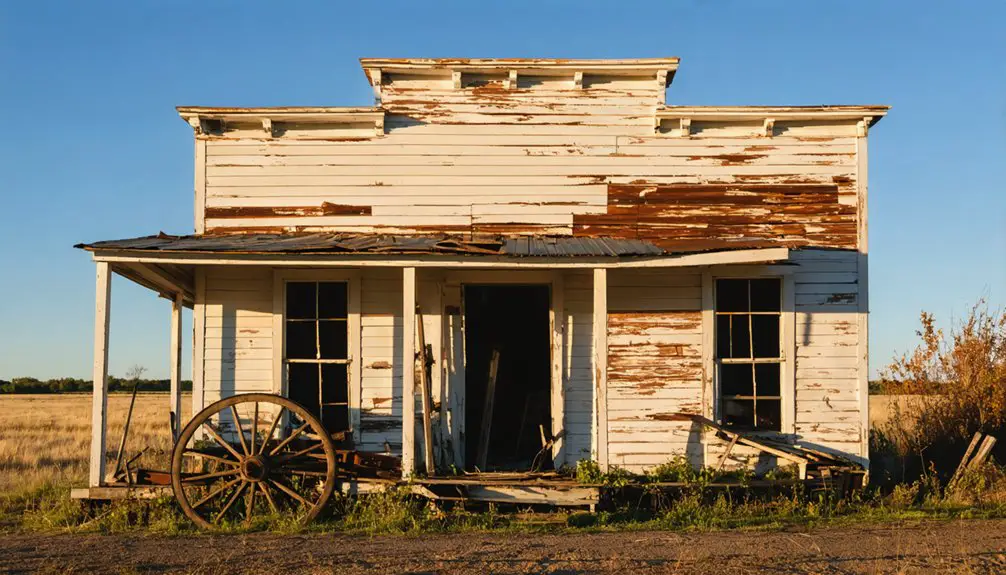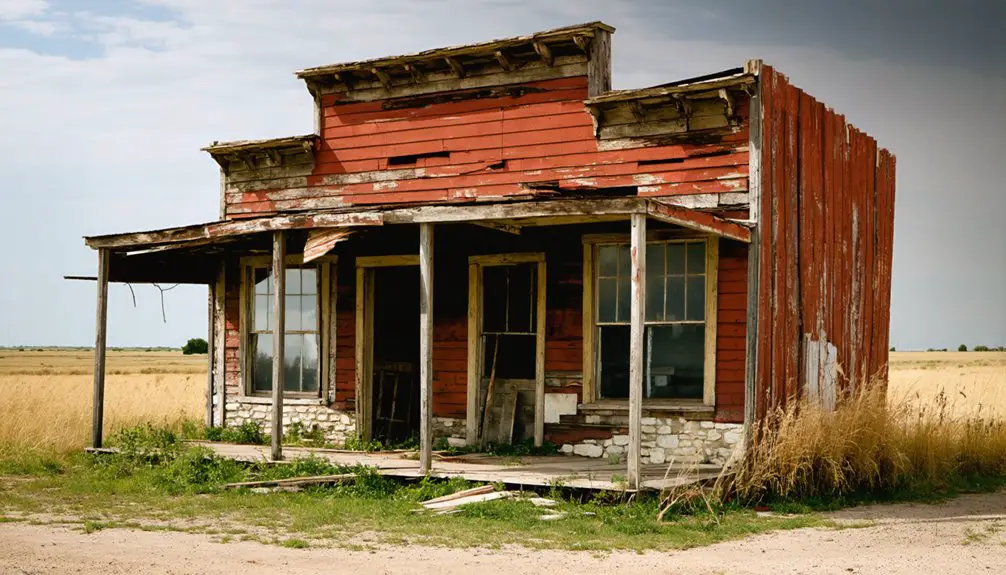You’ll find Moral, Oklahoma’s ruins in Pottawatomie County, where this unique temperance town emerged in 1892. Founded by Brooks Walker with strict alcohol prohibition, the community featured wooden buildings, farms, and a tight-knit Protestant population. While neighboring liquor towns prospered, Moral’s economic limitations led to its decline after Oklahoma statehood in 1907. Today, only the cemetery remains, its weathered headstones holding the secrets of this fascinating experiment in dry living.
Key Takeaways
- Founded in 1892 as a temperance town in Pottawatomie County, Oklahoma, with strict restrictions on alcohol sales and consumption.
- The town declined after Oklahoma statehood in 1907, unable to sustain itself due to limited economic opportunities.
- Only the cemetery remains today, featuring weathered headstones and iron crosses from the late 1800s and early 1900s.
- Moral’s economy struggled against neighboring liquor towns, highlighting the challenges of maintaining a strictly alcohol-free community.
- The town existed for just 16 years (1892-1908) before becoming a ghost town, leaving behind a legacy of temperance values.
The Birth of a Temperance Town
When settlers staked their claims in Pottawatomie County on April 22, 1892, they established Moral, Oklahoma with a distinct vision – to create a community entirely free from alcohol’s influence.
Located just two miles north of Trousdale, this pioneering settlement reflected the growing national temperance movement of the late 19th century.
You’ll find that Moral’s founders weren’t taking any chances with their alcohol-free vision. They embedded temperance ideals directly into the town’s property deeds, restricting liquor sales and consumption from day one.
Much like Moore’s early settlement during the land run of 1889, these frontier communities were shaped by the values and determination of their founding residents.
The settlement quickly attracted like-minded individuals and families seeking an alcohol-free environment. Community gatherings and local institutions reinforced these values, creating a distinct social structure that set Moral apart from surrounding settlements where alcohol flowed freely. Like the reform factions that would later emerge in Guthrie, Moral’s residents framed their mission as a moral battle between good and evil.
Daily Life in Early Moral
Life in early Moral centered around self-sufficiency and communal support, reflecting the practical needs of frontier settlement.
You’d find wooden frame buildings and log cabins with multipurpose rooms where families cooked, slept, and gathered. Settlement structures included a church and general store, connected by simple dirt paths.
Your daily routine would’ve involved tending to crops like maize and cotton, or caring for livestock. You’d join neighbors for church services, baseball games, and community festivals.
Food came from your own labor – harvesting homegrown vegetables, hunting wild game, and preserving supplies for winter. You’d travel by foot or horseback, sharing news at the general store or church gatherings.
Most families relied on bartering and local exchange, working together to overcome frontier challenges. Like other pioneer families across Oklahoma Territory, settlers built homes and farms from raw prairie sod, facing harsh environmental conditions. After claiming their 160-acre plots, families had to prove their commitment by maintaining five years residence on the land.
The Rise and Fall: 1892-1908

Founded in 1892 by Brooks Walker, Moral emerged as a unique settlement in Pottawatomie County, Oklahoma Territory, distinguished by its strict prohibition of alcohol sales.
While neighboring towns profited from the liquor trade, Moral’s community values emphasized temperance and order, creating economic struggles as it relied solely on local commerce and small businesses. Like characters in moral tales, the town’s founders aimed to teach through example and righteous behavior.
Many thriving whiskey towns thrived along the border until Oklahoma statehood brought an end to their profitable trade in 1907.
The town’s fate shifted dramatically when Oklahoma gained statehood in 1907 as a “dry” state.
Though this development aligned with Moral’s founding principles, it couldn’t save the struggling settlement.
Despite the elimination of its neighbors’ alcohol-based economic advantages, Moral lacked the infrastructure and economic diversity to sustain itself.
Legacy of a Dry Community
The enduring impact of Moral’s dry status stretched far beyond its brief sixteen-year existence. As a town founded explicitly to ban saloons, Moral’s prohibition stance created strong community cohesion among its Protestant residents, who viewed alcohol abstinence as a moral virtue.
You’ll find that while nearby “liquor towns” prospered from alcohol-related commerce, Moral’s commitment to temperance created stark economic contrasts in the region. The Anti-Saloon League actively supported the town’s establishment as a model dry community. The town’s religious foundations helped sustain its dry legacy even as prohibition laws changed across Oklahoma. Local residents often made lengthy drives elsewhere to purchase alcohol, a common pattern that persists in dry counties today.
Today, Moral’s story serves as an indication of how alcohol policies shaped community development in early Oklahoma Territory. While the town itself faded into history, its reputation as a moralistic stronghold continues to intrigue those studying the state’s temperance movement.
What Remains Today: The Cemetery
Among the scattered remnants of Moral’s past, you’ll find its cemetery standing as a poignant memorial to the town’s brief existence.
Like Jesse Harrison Milner, many prominent early residents were laid to rest here between the late 1800s and early 1900s. The site’s weathered headstones and iron crosses tell stories of early settlers, while nature steadily reclaims the grounds. Similar to the Dawson cemetery which expanded after the 1923 mining disaster, many small-town graveyards grew with tragic events that shaped their communities. Cemetery preservation efforts face significant challenges, with minimal maintenance and complicated land ownership issues threatening these historic markers.
- Graves date back to the early 20th century, marking the final resting place of pioneers and veterans
- Paranormal encounters mirror those of other Oklahoma ghost town cemeteries, including apparitions and unexplained voices
- Irregular boundaries shaped by forestry and hunting clubs impact accessibility
- Natural erosion and vandalism contribute to the loss of historic inscriptions
- The cemetery remains one of the few physical links to Moral’s history
Frequently Asked Questions
What Were the Names of Prominent Families Who Lived in Moral?
You won’t find specific prominent residents or family legacies documented in available records. While families certainly lived there during 1892-1908, their names weren’t preserved in accessible historical archives.
Did Any Notable Crimes or Incidents Occur in Moral During Its Existence?
You’d expect a town called “Moral” to have some juicy scandals, but historical records don’t show any infamous events or notable crimes during its existence from 1892 to 1908.
What Crops or Agricultural Products Were Primarily Grown Around Moral?
You’ll find that cotton farming dominated the area’s agriculture, alongside corn and winter wheat production. Local farmers also engaged in livestock raising, particularly cattle and pigs for market.
Were There Any Churches or Schools Established in the Town?
Truth is stranger than fiction – you won’t find any documented church history or education legacy in official records. Historical sources don’t confirm the existence of churches or schools during Moral’s brief existence.
What Was the Maximum Population of Moral at Its Peak?
You won’t find Moral’s exact peak population in historical records. Based on its small-town history and ghost town status, researchers estimate it likely never exceeded a few hundred residents.
References
- https://en.wikipedia.org/wiki/List_of_ghost_towns_in_Oklahoma
- https://sites.rootsweb.com/~okpcgc/towns/moral.html
- https://www.okhistory.org/publications/enc/entry?entry=GH002
- https://en.wikipedia.org/wiki/Moral
- https://okmag.com/blog/a-ghostly-site/
- https://gateway.okhistory.org/ark:/67531/metadc2031882/
- https://www.youtube.com/watch?v=Cz6GBalN5wc
- https://en.wikipedia.org/wiki/List_of_temperance_towns
- http://www.historyofmoore.com/moore-history&cat_id=3
- https://www.okhistory.org/publications/enc/entry?entry=SE024



